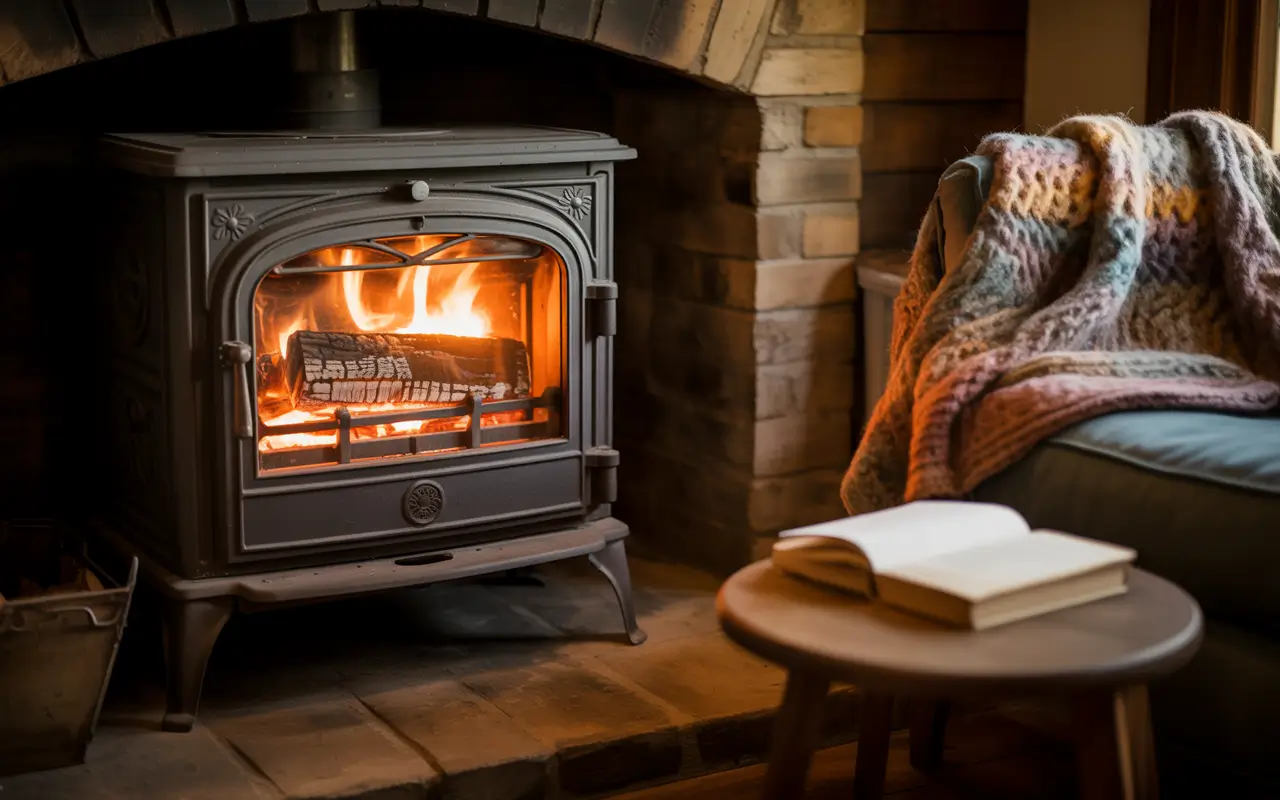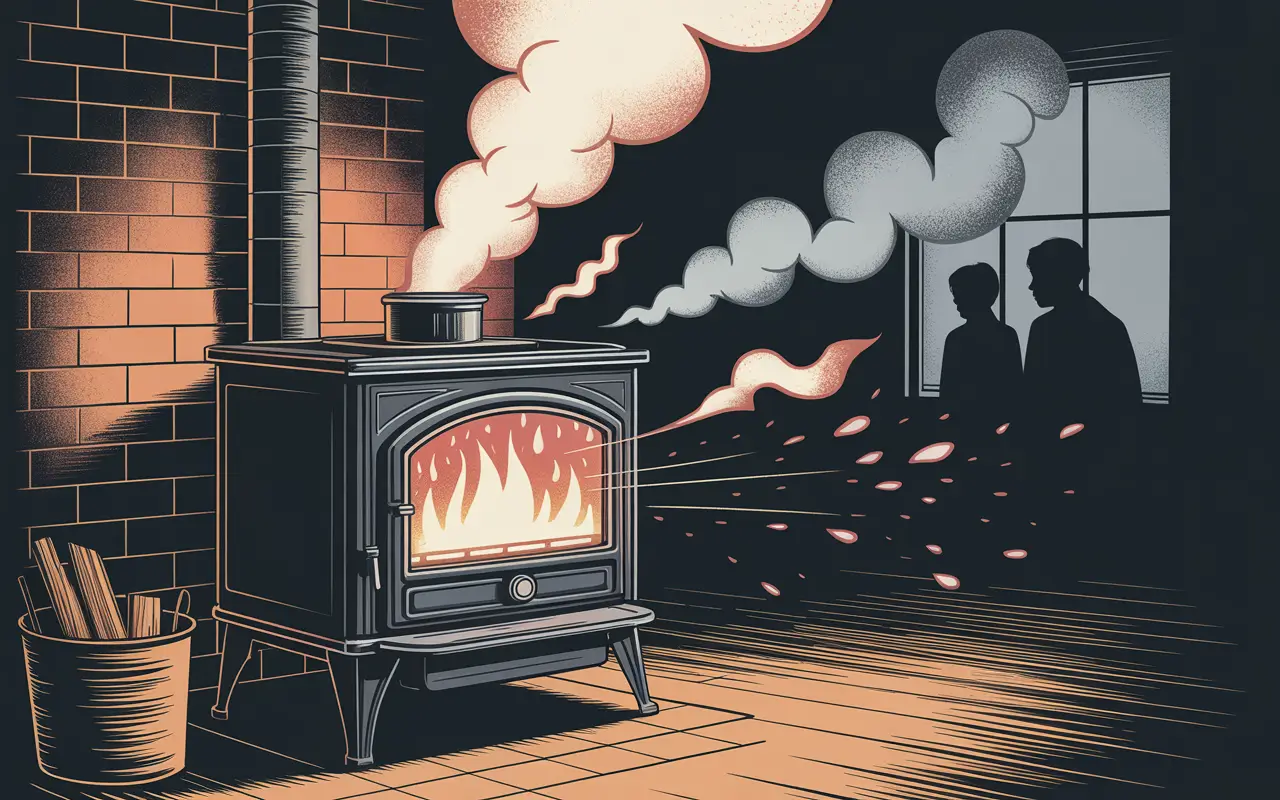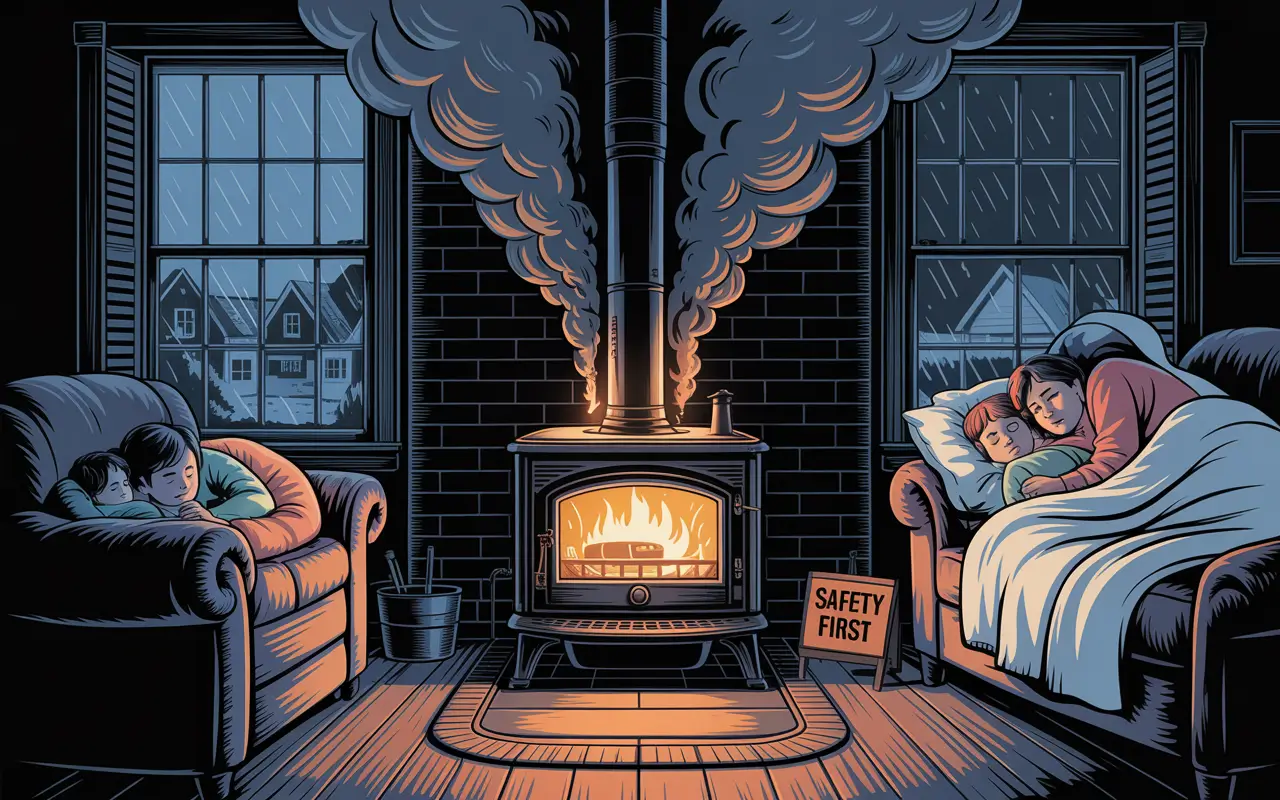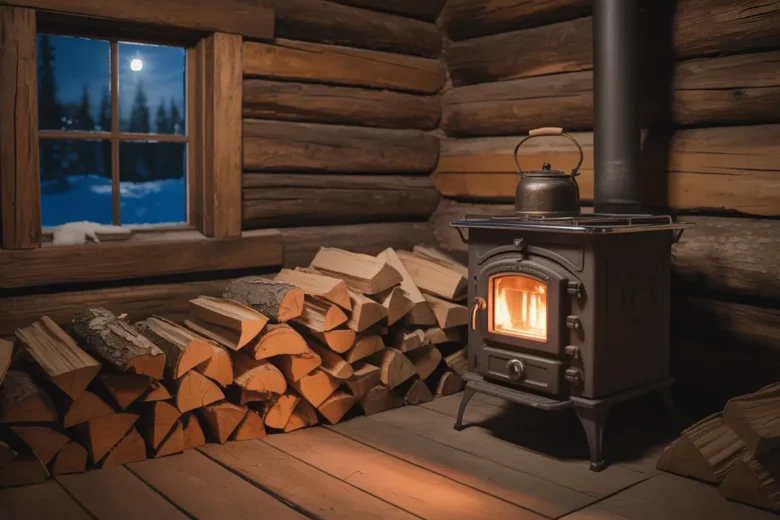There’s nothing more comforting on a cold winter night than the steady glow and warmth of a wood stove. But as bedtime approaches, many homeowners pause and wonder:
Is it really safe to let the stove keep burning overnight?
The short answer is — it can be, but only if you’re using the right equipment, following proper safety practices, and understand the risks involved. From creosote buildup and poor ventilation to malfunctioning seals or door latches, running a wood stove while you sleep isn’t without danger.
In this guide, we’ll cover everything you need to know before letting your fire burn through the night. You’ll get expert tips on how to minimize fire hazards, improve ventilation, and identify warning signs that your stove setup might not be safe. Whether you rely on your stove daily or only during the coldest months, this article will help you sleep warmer — and safer.
Why Homeowners Run Wood Stoves Overnight

For many homeowners—especially in cold regions or off-grid cabins—running a wood stove overnight isn’t just a convenience, it’s a necessity. Letting the fire burn through the night helps maintain a comfortable indoor temperature and saves time relighting a cold stove in the morning.
🌡️ 1. Maintaining Warmth During Frigid Nights
Temperatures often drop sharply at night, particularly in rural or mountainous areas. A wood stove that burns consistently can:
-
Prevent frozen pipes in bathrooms or basements
-
Reduce the need for electric backup heating
-
Maintain consistent humidity and comfort levels
If you rely solely on wood heat, letting the fire go out overnight can mean waking up to icy floors and a major restart process.
⏳ 2. Fuel Efficiency and Longer Burn Times
Modern stoves—especially EPA-certified models—are designed for slow, efficient burning. With the right setup, you can load the stove before bed and enjoy:
-
6–8 hour burn cycles
-
Less wood consumption overall
-
A steady, slow heat release (great for log homes)
🔥 3. Modern Stove Technology Makes It Possible
Today’s high-efficiency stoves are far safer and better sealed than their older counterparts. Many include:
-
Airtight doors with gasket seals
-
Secondary burn systems for cleaner emissions
-
Heat-retaining firebrick interiors
These features make it safer to let them burn unattended—as long as they’re properly maintained.
❄️ 4. Overnight Burning Is Common in Rural & Off-Grid Homes
If you’re heating a remote cabin or off-grid home, the wood stove may be your only heat source. Overnight burning becomes a regular part of daily life—but must be done responsibly.
📚 Related Reading: How to Choose the Right Stove for Your Home – StovesHQ
The Real Safety Concerns to Consider

While the idea of a warm, glowing stove throughout the night sounds comforting, running a wood stove overnight carries several potential risks that should never be ignored. Understanding these dangers is essential for preventing accidents and keeping your home — and your family — safe.
🔥 1. Creosote Buildup and Chimney Fires
When wood is burned incompletely, it produces creosote, a tar-like substance that sticks to the inside of your chimney. Overnight burns, especially smoldering fires with restricted airflow, accelerate creosote formation.
-
Creosote is highly flammable
-
Buildup increases with unseasoned wood or poor ventilation
-
Can cause dangerous chimney fires if not cleaned regularly
🔗 More on creosote dangers from the Chimney Safety Institute of America (CSIA)
🛑 2. Carbon Monoxide Risk from Poor Draft
A smoldering or incomplete burn can release carbon monoxide (CO) — a colorless, odorless gas that’s deadly in enclosed spaces.
-
Caused by lack of oxygen or poor stove draft
-
May enter the room if your stove’s seals are worn or chimney is blocked
-
CO detectors are absolutely essential for overnight burning
🔥 3. Sparks or Embers Escaping the Firebox
Even small sparks can ignite nearby rugs, curtains, or wood trim—especially if:
-
The stove door isn’t sealed properly
-
A log rolls and pushes the door slightly open
-
There’s no spark screen or fireproof mat
⚠️ 4. Faulty Stove Components
Over time, wood stove parts wear out:
-
Gaskets become brittle
-
Glass panels may loosen
-
Hinges and latches can fail
If these go unnoticed, your stove may look closed and secure — but leak heat, smoke, or sparks during the night.
Expert-Backed Tips for Overnight Stove Use

If you’ve decided to run a wood stove overnight, doing it safely is all about preparation, the right equipment, and responsible habits. Here are expert-approved strategies to help you reduce the risks while enjoying the warmth through the night.
🌲 1. Burn Only Seasoned Hardwood
Unseasoned or damp wood produces more smoke and creosote. Instead, choose:
-
Seasoned hardwoods like oak, maple, or ash
-
Logs that have dried for at least 6–12 months
-
Wood with moisture content below 20% (use a moisture meter)
🔒 2. Ensure the Door Is Properly Sealed
Always close and latch the stove door securely. Check:
-
Gasket integrity: Replace if cracked or fraying
-
Door hinges and latches: Should be tight and smooth
-
Glass panels: Should not rattle or have gaps
A loose door = smoke, embers, or CO escaping while you sleep.
🧯 3. Install Smoke and Carbon Monoxide Detectors
This is non-negotiable for any home using a wood stove overnight. Place detectors:
-
Near the stove and in sleeping areas
-
Test monthly and replace batteries twice a year
-
Choose detectors with digital displays and long-life sensors
📚 Related: Can I Install a Stove Pipe Myself? Safety, Codes, and Best Practices – StovesHQ
🔥 4. Use a Spark Arrestor and Fireproof Mat
These add another layer of protection in case of flare-ups or ember pops:
-
Spark arrestors on chimney caps prevent sparks from exiting your flue
-
A fireproof mat protects your floor from falling embers
-
Wall shields or heat-resistant panels can reduce clearance risks
Stove & Chimney Setup for Safer Overnight Use
A big part of overnight stove safety doesn’t just depend on what you burn — it depends on how your stove and chimney system are installed and maintained. Making sure your setup meets safety standards can drastically reduce the risk of fire, backdrafts, or dangerous heat exposure.
✅ 1. Use a UL-Listed or EPA-Certified Stove
Certified stoves meet strict safety and emissions standards. Look for:
-
UL 1482 or EPA certifications on the label
-
Models with airtight doors, airwash systems, and secondary burn chambers
-
Manufacturer specifications for burn times and safe overnight use
🔥 2. Install Insulated Double-Wall Stove Pipe
Double-wall pipes help:
-
Maintain higher flue temperatures (improving draft)
-
Reduce creosote buildup
-
Allow for closer clearance to walls or ceilings safely
If your stove connects through a wall or ceiling, use a UL 103 HT-rated chimney system.
🧱 3. Respect Clearance Guidelines to Combustibles
Refer to NFPA 211 and your stove’s manual. In general:
-
Single-wall pipe: needs 18 inches clearance
-
Double-wall pipe: can reduce to 6 inches
-
Use heat shields to reduce clearances even further
-
Keep flammable items (curtains, furniture, rugs) at least 3 feet away
📚 Related: Installation Codes and Safety Clearances – StovesHQ
🔍 4. Schedule an Annual Chimney Inspection
Over time, debris, creosote, or small cracks can compromise your system. Get your stove and chimney inspected:
-
At least once per year
-
By a CSIA-certified chimney sweep
-
Especially before winter begins
This ensures everything is functioning efficiently and safely before you consider burning overnight.
When You Should NOT Leave a Wood Stove Burning

Although many modern wood stoves are designed to burn safely for hours, there are specific situations where running a wood stove overnight is not recommended at all. Ignoring these warning signs can lead to serious hazards—even with a high-quality stove.
⚠️ 1. If Your Stove Is Old or Poorly Maintained
Older stoves or systems that haven’t been serviced in years may have:
-
Worn-out door gaskets
-
Cracked fire bricks or warped components
-
Damaged stovepipe or chimney joints
If you’re unsure of your stove’s condition, don’t leave it running while you sleep. Schedule a professional inspection first.
💤 2. If You’re Leaving the House or Sleeping in Another Room
Unless you can monitor the stove from nearby, it’s better to let the fire die out:
-
Burning unattended in a different room increases response time if something goes wrong
-
CO detectors may not alert you in time if they’re too far away
-
Fires can escalate quickly if no one is present
🌬️ 3. During High Wind or Storm Conditions
Wind gusts can affect draft and backflow, especially in homes with tall or poorly insulated chimneys. Risks include:
-
Backdrafting smoke and CO into the home
-
Fluctuating flame intensity
-
Blown embers if the door isn’t sealed tightly
🚫 4. If You Notice Any Signs of Malfunction
Immediately stop overnight use if you notice:
-
Smoke leaking from joints or around the door
-
Unusual smells (plastic, burning creosote, etc.)
-
Strange noises like popping or sucking sounds from the pipe
These could indicate a blockage, leak, or structural issue.
📚 Related: How to Properly Clean Your Wood Stove Pipe – StovesHQ
Running a wood stove overnight can be safe — but only when done with intention, care, and the right equipment. From using seasoned hardwood to checking your stove’s seals and maintaining proper clearance, each small step adds up to a warmer and safer night.
Modern EPA-certified stoves are designed for long, slow burns, but no stove is safe without regular maintenance and responsible use. Whether you’re heating your home full-time or just trying to stay warm on winter weekends, understanding the risks and applying expert-backed safety tips will give you peace of mind as the fire glows through the night.

